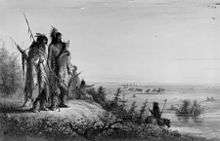Thomas Fitzpatrick (trapper)
Thomas Fitzpatrick (1799 – 7 February 1854), known as "Broken Hand" (reportedly because his left hand had been mangled in a firearms accident), was a famous Irish-American "mountain man", "friend of the Indians", trailblazer and trapper with the Rocky Mountain Fur Company. With Jedediah Smith, he led a trapper band that discovered South Pass, Wyoming; however, before that Robert Stuart led the first known white party through the South Pass.
Thomas Fitzpatrick | |
|---|---|
| Born | 1799 |
| Died | February 7, 1854 (aged ~55) |
| Resting place | Congressional Cemetery |
| Nationality | Irish-American |
| Other names | "Broken Hand" |
| Occupation | Mountain Man, trailblazer, trapper, Indian agent |
| Spouse(s) | Margaret Poisal |

He shepherded the first two emigrant wagon trains to Oregon, including the Bartleson-Bidwell Party in 1841. He was the official guide to John C. Fremont on his second, and longest, expedition in 1843–44. He guided Col. Stephen W. Kearny and his Dragoons along the westward trails in 1845 to impress the Native Americans with their howitzers and swords.
Fitzpatrick helped negotiate the Fort Laramie treaty of 1851, at the largest council ever assembled of Native Americans of the Plains. He spoke Native American languages and deeply respected them as well. Among the most colorful and highly regarded of mountain men, Fitzpatrick was also party to many of the most important events in the expansion of the West.
In 1849, Fitzpatrick married Margaret Poisal, an Arapaho woman and the niece of Arapaho Chief Niwot. Poisal served as an important translator for the Arapaho peoples and often worked alongside Fitzpatrick at important meetings. After his death, Poisal served as the official interpreter for the Arapaho during the Little Arkansas Treaty Council in 1865.[1][2]
In the winter of 1853–54, Fitzpatrick went to Washington, D.C., to see after treaties that needed to be approved, but while there contracted pneumonia and died on February 7, 1854.[3] He was buried in the Congressional Cemetery there.
In the 1966 episode "Hugh Glass Meets the Bear" of the syndicated television series, Death Valley Days, the actor Morgan Woodward was cast as Fitzpatrick. John Alderson played Hugh Glass, who after being mauled by a bear and abandoned by Fitzpatrick crawled two hundred miles to civilization. Victor French was cast as Louis Baptiste, with Tris Coffin as Major Andrew Henry.[4]
Fitzpatrick appears to have been confused or conflated with John S. Fitzgerald, who, according to the Encyclopedia of Frontier Biography, was actually the one who left Glass behind.[5]
In 2004, he was inducted into the Hall of Great Westerners of the National Cowboy & Western Heritage Museum.[6]
Books
- Hafen, LeRoy R. and Ghent, W.J., Broken Hand. The Life Story of Thomas Fitzpatrick, Chief of the Mountain Men. Denver: Old West Publishing Co., 1931. Reprinted by University of Nebraska Press, 1973.
- Pedersen, Lyman C., "Warren Angus Ferris", in Trappers of the Far West, Leroy R. Hafen, editor. 1972, Arthur H. Clark Company, reprint University of Nebraska Press, October 1983. ISBN 0-8032-7218-9
- Utley, Robert M.; Dana, Peter M. (2004). After Lewis and Clark: Mountain Men and the Paths to the Pacific. Lincoln: U of Nebraska Press.
References
- Coel, Margaret, 1937- (2000). Chief Left Hand, Southern Arapaho. University of Oklahoma Press. OCLC 47122540.CS1 maint: multiple names: authors list (link)
- Hafen, LeRoy R. (LeRoy Reuben), 1893-1985. (1981) [1973]. Broken Hand, the life of Thomas Fitzpatrick, mountain man, guide and Indian agent. University of Nebraska Press. ISBN 0-8032-7208-1. OCLC 981577386.CS1 maint: multiple names: authors list (link)
- The New Encyclopedia of the American West, ed. Howard R. Lamar. Yale University Press (1998)
- "Hugh Glass Meets the Bear on Death Valley Days". Internet Movie Data Base. March 24, 1966. Retrieved September 9, 2015.
- Thrapp, Dan L. (1991-08-01). Encyclopedia of Frontier Biography: G-O. U of Nebraska Press. ISBN 0803294190.
- "Hall of Great Westerners". National Cowboy & Western Heritage Museum. Retrieved November 22, 2019.